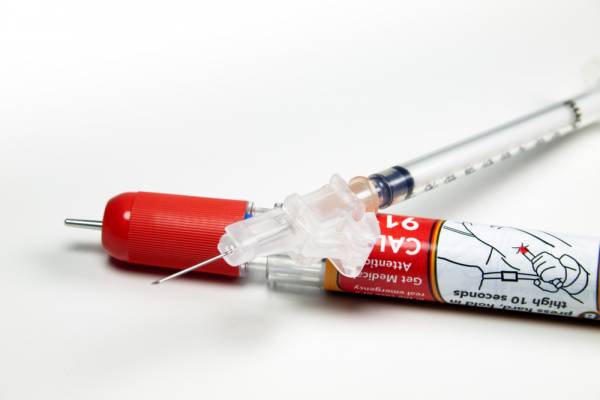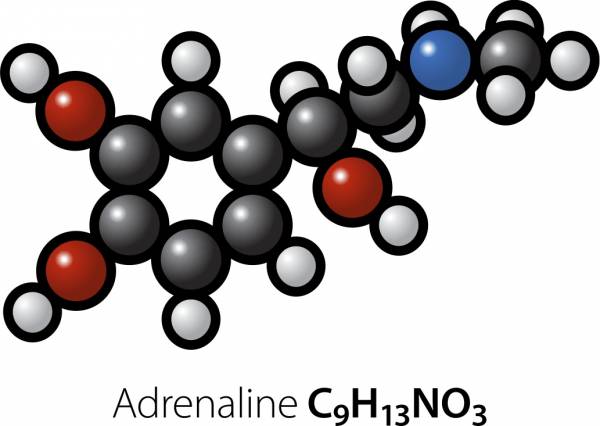Last week we learned the basics about norepinephrine: how and where it’s made, how and why it’s released, and some basics on how its function in the body can get thrown off track.
Epinephrine – Norephinephrine’s Sidekick
As part of the adrenal system, we know keeping our norepinephrine levels in check is important in maintaining energy levels, alertness, appropriate stress responses, mental health, and of course, great athletic performance and body composition. However, it’s just one part of the adrenal puzzle. This week, I want to focus on epinephrine, norepinephrine’s sidekick. Norepi and epinephrine function well together and where you find one, you almost always find the other. (Think Batman and Robin.)
Like norepinephrine, epinephrine – also known as adrenaline – is a catecholamine that acts as both a neurotransmitter and hormone. It’s an antagonist of alpha-1, alpha-2, beta-1, and beta-2 receptors throughout the body. It’s produced by the adrenal medulla and the central nervous system and is a major component of the “flight or fight” response. It gets us ready to handle stress by increasing heart rate, blood pressure, and the ability of the heart to pump blood efficiently. It causes vasoconstriction, or the clamping down, of some blood vessels and vasodilation, or the relaxation, of others. It also causes bronchodilation and increased respiration. This opens the airways and allows for better oxygen delivery to the cells of the body, as well as CO2 removal from the bloodstream.
Epinephrine also triggers some metabolic changes that free up quite a bit of glucose. The liver stops producing insulin and the muscles and liver break down glycogen into glucose. Glycolysis is triggered in the muscles, which involves the breakdown of glucose into pyruvate. This in turn enables the formation of ATP and the fueling of muscular contraction. Another energy source is accessed as the triggering of lypolysis breaks down fat into ketones (the other energy source). Short story, epinephrine frees up energy to be used by the muscles and brain in response to the perceived stressor.
 Epinephrine is often administered as a drug. It’s used in cases of cardiac arrest due to its ability to increase cardiac output, increase blood flow to the heart, and increase blood pressure. It also is used to treat anaphylaxis, bronchospasm/asthma, and even hypoglycemia. Ever seen or heard of an EpiPen? People with severe allergies usually carry them at all times. This is basically nothing but straight epinephrine meant to protect the individual carrying it from going into anaphylactic shock if exposed to their allergen.
Epinephrine is often administered as a drug. It’s used in cases of cardiac arrest due to its ability to increase cardiac output, increase blood flow to the heart, and increase blood pressure. It also is used to treat anaphylaxis, bronchospasm/asthma, and even hypoglycemia. Ever seen or heard of an EpiPen? People with severe allergies usually carry them at all times. This is basically nothing but straight epinephrine meant to protect the individual carrying it from going into anaphylactic shock if exposed to their allergen.
Epinephrine is made in the same way norepinephrine is made. In fact, you must have norepinephrine to make epinephrine. Again, the amino acids phenylalanine and tyrosine are the building blocks of the fight or flight hormones. If you are lacking phenylalanine or tyrosine in your diet, you need to either supplement or include foods high in those amino acids. Tyrosine is used to first make L-DOPA, L-DOPA is converted to dopamine, and dopamine is converted to norepinephrine. Then, within the chromaffin cells of the adrenal medulla and cytosol of the adrenergic neurons, norepinephrine is methylated (a fancy words that means an enzyme adds a methyl group to a substance) and converted to epinephrine. Epinephrine is then stored in chromaffin cells of the adrenal medulla until it’s needed in the body. Whew.
Now, how do we get the adrenaline out of the chromaffin cell? First, the sympathetic nervous system (SNS) and adrenocorticoptropin hormone (ACTH) kick off the synthesis of adrenaline. ACTH also causes the adrenal cortex to release cortisol (another stress related hormone) enhancing epinephrine synthesis even further. At the same time, the SNS stimulates the release of epinephrine by the chromaffin cells into the blood stream. And what stimulates that release? Perceived and actual stressors like loud noises, bright lights, higher temperatures, a big meeting with the boss, or anticipating a hard workout or lift. Anything that causes you to feel as though you need to be ready to defend yourself, causes the body stress (real or perceived), or brings you anxiety can cause a release of adrenaline.
 The action of adrenaline is terminated by the reuptake of the hormones into nerve receptors and metabolism by different enzymes. Unlike many other hormones, epinephrine does not down-regulate it’s own production. So, it is possible to have chronically elevated adrenaline levels in the body. It’s the like annoying party guest that doesn’t know when to leave. This can be caused by numerous things such as administration of exogenous epinephrine or tumors in the adrenals or along other parts of the sympathetic nervous system. Also, the body can also have problems making enough epinephrine, as is the case in Addison’s disease and adrenal fatigue.
The action of adrenaline is terminated by the reuptake of the hormones into nerve receptors and metabolism by different enzymes. Unlike many other hormones, epinephrine does not down-regulate it’s own production. So, it is possible to have chronically elevated adrenaline levels in the body. It’s the like annoying party guest that doesn’t know when to leave. This can be caused by numerous things such as administration of exogenous epinephrine or tumors in the adrenals or along other parts of the sympathetic nervous system. Also, the body can also have problems making enough epinephrine, as is the case in Addison’s disease and adrenal fatigue.
We now have a basic understanding about epinephrine and where it comes from, how it’s made, and what causes it to be released in the body. Now I want to start your wheels spinning so you start to think about what can go wrong if epinephrine production gets off track. If we make too much epinephrine, for too long, we can end up with a huge list of issues. The same can be said for not enough epinephrine should you wind up with a nice case adrenal fatigue.
If epinephrine affects blood pressure can too much or too little for too long cause blood pressure problems? What about this blood sugar thing? If we fail to make enough epinephrine is our blood sugar too low? What if we make a ton and our insulin production is always dampened? Also, what happens to parts of the body that aren’t getting enough blood flow because of chronic vasoconstriction due to elevated epinephrine? Makes you think, right? These adrenal hormones have some huge implications for your health and fitness. Stay tuned next week when we look at yet another part of the adrenal system.
References:
1. Oliver von Bohlen und Halbach , and Rolf Dermietzel, Neurotransmitters and neuromodulators: handbook of receptors and biological effects, (Wiley-VCH, 2006)
Photos courtesy of Shutterstock.






